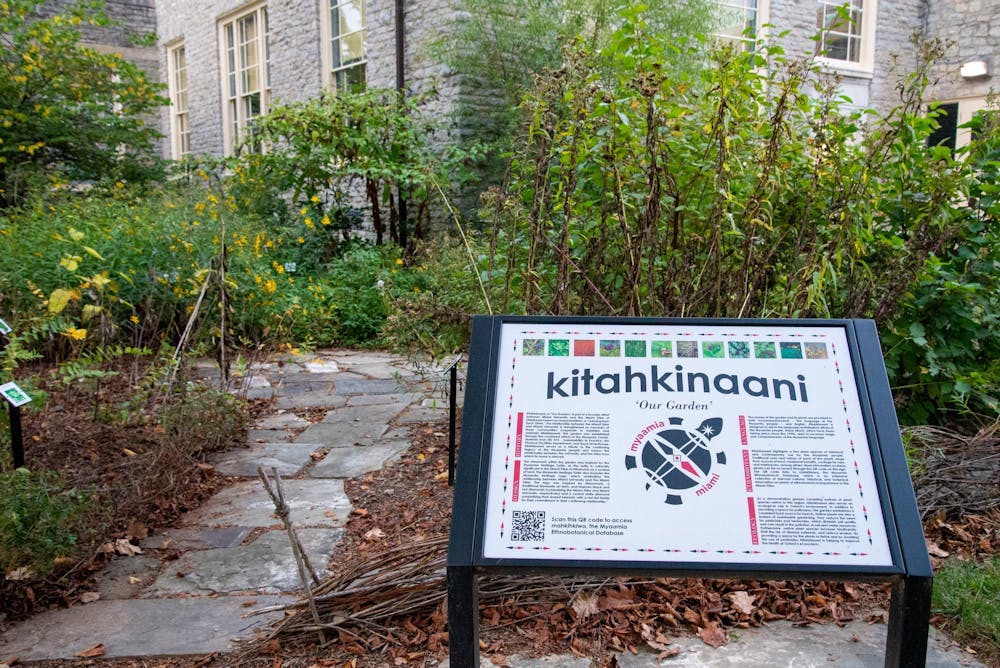Nestled in Western Campus next to the Boyd Hall greenhouse, Kitahkinaani, or ‘Our Garden,’ is a reminder of Miami University’s strong ties to the Miami Tribe of Oklahoma.
According to Sarah Dumyahn, an associate teaching professor in the Institute for the Environment and Sustainability (IES), there was no word in the Myaamia language database for ‘our garden’ that represented inclusivity; a garden meant for everyone. The language team at the Myaamia Center came together to create the name for the space and made a new entry in the Miami-Illinois indigenous digital archive.
The idea was initially proposed in 2020, when several students in the Associated Student Government Infrastructure & Sustainability committee approached IES with a proposal for more resources on campus related to Myaamia cultural revitalization.
In Spring 2021, Dumyahn took up the project with her sustainability in practice class, where students worked on a proposal with the Myaamia Center and physical facilities. The goal of the garden was to provide Myaamia students with an opportunity to engage with their heritage, as well as non-Myaamia students to learn more about the language, culture and indigenous plants.
From that semester onward, Dumyahn has worked with four to six students to cultivate Kitahkinaani. Tasks in the garden include weeding, cleaning up leaves, mending the fence, harvesting seeds and replanting as needed.
“It was an exciting way for a class to actually contribute to the cultural revitalization effort and for them to learn about the Myaamia Center,” Dumyahn said. “They learn about the Miami Tribe and Miami University relationship and help to facilitate the expansion of that on campus and to learn about it from ecological perspectives.”
Initially, students planted 12 plants native to the Ohio region. All plants are labeled in English and Myaamiaataweenki ‘the Myaamia language’ for visitors to learn from. QR codes are placed within the garden, linked in ‘mahkihkiwa,’ the Myaamia ethnobotanical database that provides information on the Myaamia words and the plants’ uses. These links provide new perspectives on plants that are often seen today as weeds, but had a significant use for the Myaamia people.
Andrew Sawyer, education outreach specialist for the Myaamia Center, said he hopes the garden will expose Miami students to the language and the tribal community that many students may not know exists.
“I noticed just a lack of awareness that the tribal community was even on campus,” Sawyer said. “Hopefully this helps expose [students] to that and give them a little more awareness that tribal citizens are here in their homelands, doing this work, and working on not just revitalizing their their traditions and culture, but helping to revitalize, maybe in a small way, some parts of the environment around us as well.”
Sawyer said outreach is a large part of his work at the Myaamia Center. One example is hosting workshops for faculty to incorporate indigenous perspectives into current and future classrooms.
He also said collaboration with the university and the tribe is a foundational part of the relationship.
“We have tribal leaders who, when they're in town, they come and interact with folks on campus,” Sawyer said. “We also provide opportunities for folks from Oxford to go to Oklahoma to directly interact with the tribe. I think that gives them a better appreciation for the tribe and the things that they’re working on.”
Enjoy what you're reading?
Signup for our newsletter
Jay Hammer, a grounds specialist at Miami, said he is there to support the Kitahkinaani and be a liaison between the physical facilities, the Myaamia Center and the academic side of Miami.
Hammer said he has visited other college campuses and seen nothing as unique as Kitahkinaani.
“This is way out of the ordinary, nothing like this has ever been seen before,” Hammer said. “It's kind of its own special little living organism, so we have to treat it differently than we do the rest of the campus.”
Moving forward, Dumyahn said she hopes to continue communication efforts about Kitahkinaani, create more opportunities for people to engage with the garden, and in the long term, grow the footprint to other spaces on campus.




